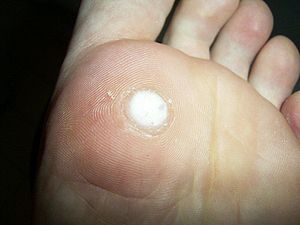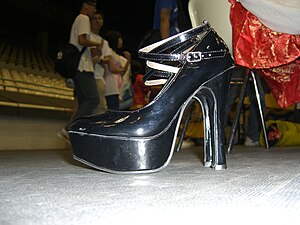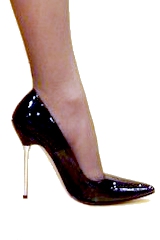 (Photo credit: Wikipedia)Do you feel an intense pain in the sole of your foot when you first step on it? Does the sole of your foot reveal a small spot similar to a callous or corn, but is extremely tender to touch? These may be signs of plantar warts.
(Photo credit: Wikipedia)Do you feel an intense pain in the sole of your foot when you first step on it? Does the sole of your foot reveal a small spot similar to a callous or corn, but is extremely tender to touch? These may be signs of plantar warts. Plantar warts are caused by a very common viral infection known as the human papillomavirus (HPV), which affects the outermost layers of the skin. Although these warts can be found in any age bracket, they are most common in young people age 12-16. They can be caused by use of public areas such as gyms or showers, and also occur from skin trauma, which allows the virus access. Since Plantar Warts occur mostly on the sole of the foot in areas that receive a lot of pressure and friction, they can be quite painful. Many warts will disappear over a period of time, and no treatment is necessary. However, in some instances the placement of these warts can affect your ability to stand or walk, and need to be treated.
Treatment of plantar warts can vary. There are over-the-counter medications, usually containing Salicylic Acid, that are generally successful. Application followed by gentle scraping can be effective. If relief is not found by use of these medications, other treatment methods such as burning, freezing or surgical removal may be necessary. Dr. Blaakman can make an evaluation, provide recommendations and treatment options.
Now is a good time to apply the “ounce of prevention…” rule. There are several steps that you can take which include:
• Avoid walking barefoot, especially in public showers and locker rooms. Use shower thongs or sandals.
• Change shoes and socks daily, and keep feet clean and dry
• Do not pick at or scratch warts as they can spread.
• Cover warts with a waterproof barrier, when in the shower, to prevent spreading
Warts can be stubborn, so work with your doctor, and be diligent with the treatment program. They know what is best for you. If you have concerns, or suspect you may have plantar warts, contact Dr. Blaakman by calling (877) 941-3338 or on Upstate Footcare's website. There is nothing like two healthy feet to get you where you need to go.
Resources:
http://www.emedicinehealth.com/plantar_warts/article_em.htm








